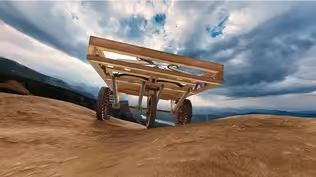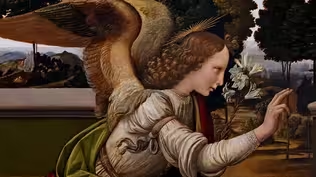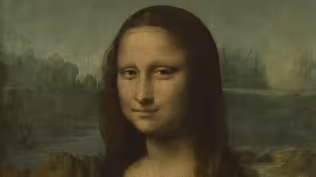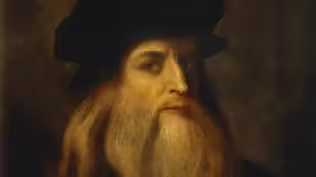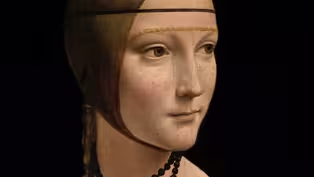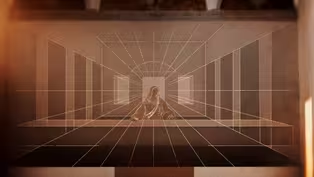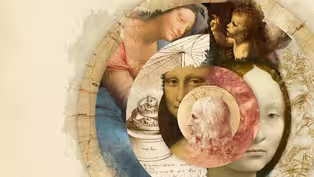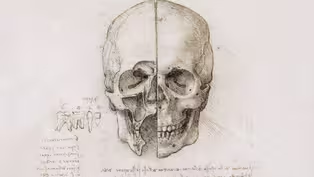
Leonardo da Vinci’s Notebooks
Clip: 11/18/2024 | 8mVideo has Closed Captions
Leonardo da Vinci’s notebooks provide unique insight into his mind, knowledge and discoveries.
More than 4,000 pages of Leonardo da Vinci’s notebooks remain. Over his lifetime, he made meticulous observations, drew fantastical flying machines, sketched castles and church architecture, invented weapons of war, and more. These surviving pages offer unique insight into the curious mind, knowledge and discoveries of Leonardo da Vinci.
Problems playing video? | Closed Captioning Feedback
Problems playing video? | Closed Captioning Feedback
Corporate funding for LEONARDO da VINCI was provided by Bank of America. Major funding was provided by the Corporation for Public Broadcasting, and by The Better Angels Society and by...

Leonardo da Vinci’s Notebooks
Clip: 11/18/2024 | 8mVideo has Closed Captions
More than 4,000 pages of Leonardo da Vinci’s notebooks remain. Over his lifetime, he made meticulous observations, drew fantastical flying machines, sketched castles and church architecture, invented weapons of war, and more. These surviving pages offer unique insight into the curious mind, knowledge and discoveries of Leonardo da Vinci.
Problems playing video? | Closed Captioning Feedback
How to Watch Leonardo da Vinci
Leonardo da Vinci is available to stream on pbs.org and the free PBS App, available on iPhone, Apple TV, Android TV, Android smartphones, Amazon Fire TV, Amazon Fire Tablet, Roku, Samsung Smart TV, and Vizio.
Buy Now
Providing Support for PBS.org
Learn Moreabout PBS online sponsorshipNarrator: Leonardo moved into a spacious studio and living quarters at the Corte Vecchia, a former palace adjacent to Milan's colossal cathedral.
In the new workshop, which he would refer to as "la mia fabrica," my factory, Leonardo would paint portraits, draw futuristic machines, and make meticulous observations in dozens of notebooks.
[Dog barks] Borgo, speaking Italian: Nicholl: I think we get close to a key quality of Leonardo in the notebooks.
It's not just that Leonardo knew an awful lot.
It's that he found out an awful lot.
Man as Leonardo: What light and shadow are?
What outlines are seen in trees?
What rules should be given to boys learning to paint?
Nicholl: The way he found out was by asking questions... Man as Leonardo: Why the sun appears larger when setting than at noon when it is nearer to us?
Nicholl: and indeed the interrogative mode is quite often present in the notebooks.
Man as Leonardo: [Speaking Italian] Nicholl: Why is that happening?
Man as Leonardo: [Speaking Italian] Nicholl: How does it happen?
Man as Leonardo: [Speaking Italian] Nicholl: What is the quality of that thing or person or emotion?
Man as Leonardo: [Speaking Italian] Nicholl: He's posing questions and looking for answers.
Man as Leonardo: [Speaking Italian] Del Toro: The beauty of what he does is that he is carrying a catalog of notions that are organized almost like a stream of consciousness.
Man as Leonardo: [Speaking Italian] Del Toro: His knowledge knows no boundaries.
[Splash] [Lion roars] The way we absorb the world is all at once, and that's the simultaneous, gluttonous impact that you get from his notebooks.
He has to be there, and he has to render it right away.
Man as Leonardo: Define first what is meant by height and depth, also how the elements are situated... Narrator: In one notebook, he designed a city built on two levels to improve sanitation; sketched castle and church architecture, including a study for the dome of Milan's cathedral; and invented weapons of war.
♪ Leonardo also drew fantastical flying machines.
♪ Vecce, speaking Italian: Narrator: He wasn't the first to imagine conquering the skies.
Daedalus, a mythic craftsman of ancient Greece, had fashioned wings for himself and his son Icarus in an effort to escape their captors on the isle of Crete.
♪ Aspiring aviators in China, Iran, Scotland, and elsewhere had designed machines and made ill-fated attempts at flight.
♪ Man as Leonardo: Remember that your flying machine must imitate the bat because the web, being connected to the structure, gives strength to the wings.
Narrator: Many of Leonardo's designs were ornithopters, machines that relied on the human-powered flapping of wings to achieve flight.
His wings would be constructed of cane, rope, and fine linen, the lightest materials he could find.
Pilots would use pulleys and cords to coordinate movement and pedals and cranks to supply power.
Man as Leonardo: A man with large enough wings duly connected might overcome the resistance of the air and succeed in conquering it and rising above it.
♪ Man: In order to achieve lift, he needed to create, basically, a deflection of the air.
We are flying because we are able to redirect the airflow from horizontal to downward.
And Newton's law says that if you deflect it downward, the reaction to it is, it pushes you up, and he basically understood that without being able to explain it.
♪ Narrator: Though ingenious and of singular artistic beauty, his flying machines could not have flown.
The materials of his day were too heavy and human musculature too weak.
♪ Man as Leonardo: The dragonfly flies with 4 wings, and when the front wings are raised, the back wings are lowered, but each pair needs to be sufficient of itself to bear the full weight.
♪ Narrator: In the years ahead, Leonardo would fill his notebooks with drawings of a multitude of other mechanical devices-- hydraulic screws, hoists, a perpetual motion machine, clocks-- and their component parts-- springs, gears, ball bearings.
Many of his designs were utilitarian, some theoretical, but all were devised with great consideration for the properties of physics, such as friction, inertia, and gravity.
[Pottery shatters] Del Toro: There's a great little phrase Kubrick said, and I'll paraphrase him.
The lesson in the Icarus myth is not that we shouldn't fly that high.
We just need to build better wings, you know, and I think Leonardo wants to build better wings-- from irrigation to circulatory systems to machines of war, everything.
♪ Galluzzi: One of the greatest invention by Leonardo is not the submarine or the airplane.
They would not have worked, and I'm sure he was absolutely aware of that.
It's the way in which he used drawings to explain machines.
These drawings are spectacular as drawings.
♪ He's able, for the first time, to portray a complex machine with one drawing in a way that you can understand perfectly even its interior parts.
He was making exploded views aside the general view of the machine, and that was unsurpassed for many, many generations.
♪
Early Works of Leonardo da Vinci
Video has Closed Captions
Clip: 11/18/2024 | 8m 40s | Leonardo da Vinci’s first commissions are a great way to explore his early painting techniques. (8m 40s)
How Leonardo da Vinci Created Narratives in His Paintings
Video has Closed Captions
Clip: 11/18/2024 | 6m 37s | Leonardo da Vinci paints The Virgin on the Rocks and the portrait Lady with an Ermine. (6m 37s)
Leonardo da Vinci’s The Last Supper
Video has Closed Captions
Clip: 11/18/2024 | 12m 8s | In the early 1490s, Leonardo da Vinci tackled his most ambitious work yet – The Last Supper. (12m 8s)
Video has Closed Captions
Preview: 11/18/2024 | 1m 10s | Explore one of humankind’s most curious and innovative minds. (1m 10s)
The Vitruvian Man and Leonardo da Vinci's Anatomical Studies
Video has Closed Captions
Clip: 11/18/2024 | 8m 2s | Leonardo da Vinci studied anatomy to gain a deeper knowledge of how the body worked. (8m 2s)
Providing Support for PBS.org
Learn Moreabout PBS online sponsorshipSupport for PBS provided by:
Corporate funding for LEONARDO da VINCI was provided by Bank of America. Major funding was provided by the Corporation for Public Broadcasting, and by The Better Angels Society and by...

